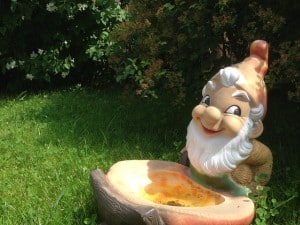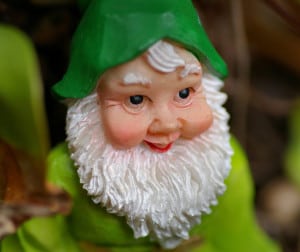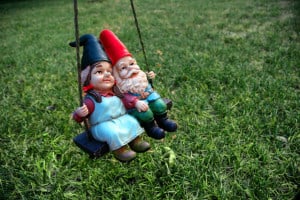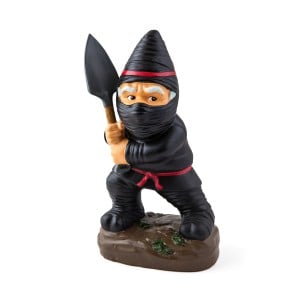Garden Gnomes – a Study
Introduction
It would be hard these days to walk around a neighbourhood that has a lot of gardens and not notice a strange small figure with a bright red hat and a white bushy beard peeking out at you from some bushes or grasses. Equally, though, the figure staring back at you could be a rendition of a character from a famous tv show such as Game of Gnomes or a move character such as the Gnominator, complete with Arnie-esque leathers, shades and gun! FS
(NB Links may be affiliate links. See my disclosure here)
But what’s it all about? These figures are well known as garden gnomes but what are garden gnomes for? Who invented garden gnomes? What do gnomes do and what is the significance of garden gnomes? Are garden gnomes evil?
Most people when they were young will have read or been told stories about fantastical creatures who live in woods, or caves, or even underground. These figures include fairies, elves, dwarfs and even smaller creatures called gnomes.
Garden Gnome Origins
The origination of the word ‘gnome’ itself causes heated debate amongst gnome academics all over the world. Some contend it was first mentioned in the 1600s by a Swiss Occultist called Paracelsus. He was said to have derived it from the latin word for earth-dweller. Others claim the word is much older but cannot be specific. Certainly gnomes have been spoken of in many different countries and there are many words for gnomes in foreign languages.
But how did the mythical gnome stories develop into a love affair with these creatures? And when and how did it become popular to put them in your garden?
I go into the origins and history of garden gnomes below. But for now, let’s just agree that they have become a common collectible amongst people who love their gardens.
 For some gardeners, collecting gnomes becomes a passion and every crevice and nook and cranny in their garden just has to be filled with a gnome of some description.
For some gardeners, collecting gnomes becomes a passion and every crevice and nook and cranny in their garden just has to be filled with a gnome of some description.
For other, more casual collectors, there has only been one or two purchases which completed an area of their garden.
A third group have even moved the gnomes indoors and placed them to decorate an indoor area such as a hearth or bathroom. Some people believe gnomes are good luck tokens and happily invite them inside their homes for protection.
Materials and Styles
There is certainly no lack of choice of material for garden gnomes these days. While the traditional garden gnomes were ceramic or terracotta, they are now available in plastic, clay and resin to name a few.
And as mentioned above, they have also broken out of the traditional gnome style of red hat and white beard into a whole range of styles. This evolution in their style has lengthened their popularity and brought a smile to many a passer-by.
Whatever your interests you will find a gnome to suit, whether your interests are football, movies or fishing. Whether you want a 3 foot garden gnome, a tiny garden gnome, specifically a male or a female garden gnome, a football gnome or even a zombie gnome, you will find what you want.
And it hasn’t stopped at just figures, either.
Gnomes have strayed into movies (Gnomeo & Juliet and Amelie), TV (Gordon the Garden Gnome, voiced by Alan Titchmarsh), books for children and advertising (Travelocity), all using the enigmatic and charming personality of the garden gnome.
How far back do Gnomes go?
The origins of the Gnome go back much further than the whimsical creatures who became massively popular decorating people’s lawns from about the 1940’s on.
They seem to have first been mentioned by the noted Swiss German astrologer and occultist Paracelsus. Although changed and romanticised and demonised (some people have questioned whether gnomes are evil or bad luck) the character he first described remains essentially the same today.
He wrote that Gnomi were mystical in nature, small in stature and lived underground, moving through the soil underground as easily as we do above ground. They are shy in nature and avoid being spotted by humans. They were said to be guardians of underground treasures.
Paracelsus may have coined the term Gnomi himself or not, but once the term appeared in his writings, the term gnome, and Gnomes themselves started to have appear in fantasist tales often to do with mines and underground treasure.
Paracelsus believed that there were invisible beings that lived alongside humans. He named them nature spirits or elementals and he divided them into four groups. Those groups were creatures of earth, air, fire and water. He classified Gnomes as earth creatures.
Once mentioned in Paracelsus’s writings, gnomes started to appear in other folklore stories and their characteristics began to be discussed more.
They came across in writings as generally kind and helpful to humans. They helped by doing people’s work during the night while the people slept.
Sometimes they were endowed with magical powers – both good and bad – with which they could choose to protect people and their property or punish them as they saw fit.
They were describes as small, overweight creatures who lived underground. The red caps and beards were almost always a feature and the descriptions were mostly of the male variety of the gnome, although it was generally thought that lady gnomes did not have beards!
A legend grew that although they were indeed alive, if they ever strayed above ground during the day, the rays of the sun would turn them to stone.
The Beginnings of Garden Gnomes
You could be forgiven for thinking that the garden gnome is a relatively new phenomenon, perhaps dating back to the 1930s or 1940’s. But in fact the garden gnome is believed to have been first popularised by a German potter called Philipp Griebel.
He began a business in the 1870’s that produced ceramic animals which were a very popular garden decoration at that time.
However, perhaps getting fed up of animals, he had the idea to produce ceramic gnomes. Gnome stories were popular in Germany and I like to think that Griebel was fascinated by them. He wanted to make a unique product that would capture the imagination of the German people, reminding them of the stories of the small red-hatted creatures who carefully tended to their gardens at night.
He had to come up with an overall image of a gnome and as they had a reputation for being underground creatures, he may have tried to copy their style of clothing and who, coincidentally or not, often wore red hats.
Griebel made the gnomes from terracotta clay which he fired in a kiln to make them more durable. He then painted them in the bright colours of the legends and his imagination.
 They were first showed in 1884 at a Leipzig market and people loved them straight away. There was massive demand for them and soon they were the only product he continued to make. People took to them in the masses, remembering the legends and believing that the little talismans guarded their homes and businesses and kept harm away.
They were first showed in 1884 at a Leipzig market and people loved them straight away. There was massive demand for them and soon they were the only product he continued to make. People took to them in the masses, remembering the legends and believing that the little talismans guarded their homes and businesses and kept harm away.
Their popularity led to several other manufacturers producing their own cloned versions of the gnome with different characteristics and painted in different colours.
His business continued to grow but he had to stop production when World War 2 broke out. After the defeat of the Nazis garden gnomes were banned but the ban didn’t last long and they were soon back on display.
Griebel’s family still make them today and they are probably one of the last companies in Germany still making them, most production having moved to lower cost base countries such as China and Poland.
How Garden Gnomes came to England
The exact date gnomes came to England is uncertain but what is certain is that the first examples were brought here by Sir Charles Isham to his home at Lamport Hall.
Isham lived at Lamport Hall for over 50 years and left it in 1899, just four years before he died.
At the time he was thought to be very eccentric and he loved to spend his time working on a private rockery at Lamport Hall. He loved the rockery and built it at the side of the hall so he could see it from his bedroom.
The rockery was 27 metres long and 14 metres wide and was created lovingly as a reduced down landscape, with small caves built in which were to represent mines. In working on it, he pioneered the use of smaller plants in gardens and landscapes.
Sir Charles was a spiritualist in nature and believed gnomes and fairies were, as he called them ‘spirits of the earth’. He was even credited with writing a book entitled ‘Notes on Gnomes’ in 1884.
Isham often visited Germany during his life and it is believed that he was intrigued by the sight of miners taking talismen down the mines with them in a spiritual way to assure their safety.
At some stage which can not be proven but was possibly after Griebel started to make gnomes popular in Germany he returned to England with a collection of gnomes, reported to be 21 in number, and placed them to live in his rockery. Allegedly his spiritual thinking led him to believe the gnomes actually lived and worked on his rockery.
The introduction of the gnomes – and perhaps Sir Charles’ written thoughts on their nature – caused quite a stir and reports of them featured in newspapers and magazines with one even appearing in Cosmopolitan in 1888.
When he died in 1903 he had stipulated in his will that the gnomes be removed from the rockery and legend has it that his daughters shot them with air rifles to destroy them.
But one had fallen into a hole and went undetected by the daughters. He stayed hidden in the hole for many years but was discovered over twenty years later and declared to be the oldest gnome in the UK and given the name ‘Lampy’. He now still lives at Lamport Hall, enjoys celebrity status and is said to be insured for two million pounds! You can visit Lamport Hall and see him today.
Garden Gnomes enjoyed a resurgence of popularity amongst the common people after the second world war and were seen as a way to cheer up and put some fun into the garden. Their numbers grew as they came to be made of plastic and manufacturers were able to use the lighter material to mould them into different shapes to represent activities such digging, fishing or working with tools. They came into the public eye more during the 1970’s with the Disney film ‘Snow White and the Seven Dwarfs’ and a book entitled ‘Gnomes’ buy Dutch authors Wil Huygen and Rien Poortvliet.
Their popularity fell from the 1980’s on and they were seen as cheap and a bit tacky. Part of the reason for this may have been the proliferation of cheap imported gnomes that gardeners got fed up. But a newspaper report in 2011 suggested they were gaining popularity and sales were growing again.
Nowadays they come in all shapes and sizes and made of many different type of materials. You can buy a football gnome, biker garden gnomes, a mooning gnome, even gnomes fashioned like the rock band KISS! You can get gnome couples and solar garden gnomes that will light up your garden.
Gnome Characteristics
There is much folklore and legend surrounding gnomes and much of it comes from Wil Huygens book.
There is further folklore generated and expanded by their inclusion in the fantasy role-playing game Dungeons & Dragons.
Garden Gnomes Nature
Gnomes are thought to be kind, hardworking folk, from mining backgrounds, who often guard treasure.
They are generally peaceful in nature, but have a natural hatred for Trolls, who hate gnomes equally. They can, though, become very aggressive if faced by enemies wishing to do them or their property damage.
Garden gnomes in particular bring good luck and are caretakers of the garden. Often in past times farmers would place gnomes in the rafters of their barns so that they might keep a watchful eye over the farmer’s livestock during the night.
They love all animals with the exception of cats and consider themselves guardians of all the forest and garden animals. Often they find, release and heal animals caught in traps or accidents and gnomes are consequently trusted and loved by all animals. They will often go fishing, but always release their catch.
Gnome Physical Attributes
Gnomes are small woodland folk, usually about 15-18 inches tall but may seem bigger because of their hats.
There are a fair number of gnome types including the Forest Gnome, the Dune Gnome, the Farm Gnome and the Siberian Gnome. The last one is different in nature to the others, having been interbred over the years. They are larger than other gnomes, have a dark and nasty nature and will associate with Trolls without worrying. Best not to cross the Siberian Gnome as they hold a grudge and have a taste for revenge.
House gnomes know more about man – often learning some of the language – and Gnome Kings are often chosen from this type.
Our main interest is in Garden Gnomes who, as the name suggests, live in gardens and act as caretakers and custodians of their own garden area.
Gnomes are much stronger than man and can run faster than most humans. They have a keen eyesight which helps them remain unseen by man.
Male gnomes wear red hats, often green or blue pants and boots. They wear a belt around their middle upon which they often hang the tools they need to do their work during the night. They have long grey beards, ruddy cheeks and often have an expanding waistline!
Female gnomes usually have long hair and often wear gray or green clothing, sporting a simple skirt down to the ankles and a blouse. She will often have knee high socks and shoes or slippers.
You can tell if a female is married or single by the way she dresses. A single female will allow her hair to hang down, sometimes in braids or pigtails and places a cloth cap on top. After she marries she will replace the cap with a scarf which she uses to cover her hair which is tied up.
They do not kiss but rub noses as a sign of affection with their mate, although sometimes a more formal noserub is a handshake-type greeting.
They do not eat meat and live on natural foods such as nuts, mushrooms, peas, potatoes and beans. For sweet tastes they will eat fruit and berries. The gnome is partial to an alcoholic drink and will drink fermented honey or raspberries and spiced gin.
Most live in various natural surroundings such as woodlands, meadows and gardens and do their best not to be seen or, if they must be seen, they are not to be seen t0 move. One trick to hide their homes is the three tree trick. They will live in a tree whose entrance is hidden in another tree with a third tree room which acts as a store and backup.
See a human made gnome stump house here.
Gnomes have an extended lifespan and can live to be up to 400 years old.
Travelling Garden Gnomes
 Gnomes are small and light, making them extremely portable. This fact, combined with some people’s dislike of gnomes and their own personal mischieviousness has led to a wicked practice known variously as Gnoming, Gnome-knapping or Gnome Roaming.
Gnomes are small and light, making them extremely portable. This fact, combined with some people’s dislike of gnomes and their own personal mischieviousness has led to a wicked practice known variously as Gnoming, Gnome-knapping or Gnome Roaming.
The basic premise was brilliant in its simplicity. The gnomenappers would steal a gnome from a garden and ‘send’ him on an adventure. The gnome would send postcards from his travels to his distraught owner and then would return overnight, often with an album of photographs of the gnomes adventures. Big chuckles all round!
One of the first documented instances was in Sydney in 1986. An owner returned home to find a note left in the spot where her gnome used to be. The note was purportedly from the gnome himself, claiming he was bored with being on his own and was off travelling to see the world, although he promised he would return. The family received a postcard a few days later telling them he was having a great time in Queensland. Two weeks later he returned with a fabulous tan which actually turned out to be shoe polish!
The prank gained a new popularity after the screening of the film Amelie in 2001. In the film a widower who had become reclusive after the death of his wife notices his gnome has been stolen. It was actually his daughter who sends the gnome on trips with a flight attendant friend who takes photos on the trip. The daughter then uses the photos to encourage her father to travel.
Gnome-knapping was stepped up a level when the prank known as The Travelling Gnome was thought up. The most well known of such pranks was that by a French organisation called the Garden Gnome Liberation Front. They take gnomes and photograph them in front of well known landmark sites, sending the photos to their bemused owners. They do this to liberate the gnome and show its owner that he is having a great time.
The Dark Side of the Gnome
Although generally a figure of laughter and happiness, there have been several occasions when we have seen the dark side of the gnome.
In 1997 the previously mentioned Garden Gnome Liberation Front was formed with a view to liberating gnomes from their safety. It was alleged that in a single year they liberated/stole over 150 gnomes and released them into the forests where they thought they belonged. In his absence the leader of the group was fined and given a suspended prison sentence for the thefts.
 The group, which were often photographed in balaclavas and military style clothing, struck again in 1998. This time, 11 gnomes were stolen during the night in a small city in eastern France called Briey. The 11 gnomes were found hanging from nooses under a bridge. A sinister handwritten note supposedly left by the gnomes declared that they would be dead by the time the note was read, and free from the selfish human world where they were treated as decorations.
The group, which were often photographed in balaclavas and military style clothing, struck again in 1998. This time, 11 gnomes were stolen during the night in a small city in eastern France called Briey. The 11 gnomes were found hanging from nooses under a bridge. A sinister handwritten note supposedly left by the gnomes declared that they would be dead by the time the note was read, and free from the selfish human world where they were treated as decorations.
In the year 2000 20 gnomes were liberated from a garden show in Paris which was displaying 2000 gnomes. The GGLF claimed the atrocity for themselves and the notion that gnomes are not just decorations and should be released into their natural forest habitat.
When 80 were stolen in a central region of France in 2006, the GGLF was the major suspect.
An Italian branch of the GGLF known as MALAG later sprung up and established the European Gnome Sanctuary in Barga. The Barga News reports on the growing number of gnomes who have run away from their gardens and decided to settle in Barga. There they have found sympathetic townsfolk who respect the gnome way of life and are prepared to fight to keep it.
They post pictures of gnomes happily seen living amongst people which can be seen here.
More sinisterly, that also showed their allegiance to the GGLF by posting their manifesto on a website here, along with distressing photos of abused gnomes.
In Cornwall in 2006 a man was reportedly threatened with arrest because he had deliberately placed his policeman character gnome, which was solar powered, so as to annoy his neighbours. The neighbours reported the nuisance to the police and he was served with notice to remove it lest he be arrested for deliberately placing the gnome to cause harassment!
Finally, as if to sour our image of gnomes as happy, peaceful people, there is a computer game called Garden Gnome Carnage. In this hateful games, a group of gnomes who detest Christmas are used to destroy Santa’s elves while swinging from ropes.
So, when you next see a funny garden gnome, just remember that occasionally, we get to see the Dark Side of The Gnome.
